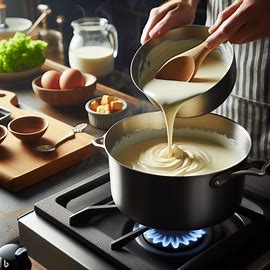How to Temper Foods: Upgrade Your Cooking Game

Let’s talk about how to temper foods, how, when, and why you should.
What is Tempering?
Tempering is a cooking technique that combines hot and cold liquids slowly and gently. It stops foods like chocolate, eggs, and cream from getting lumpy or weird when they are combined.
How Tempering Works
Tempering brings ingredients (usually two liquids) to the same temperature. A little hot liquid is steadily stirred into the cold ingredient to warm it up gradually. It also brings the temperature of the hot liquids down in a cooling process. Then, everything can be mixed smoothly without the cold stuff curdling from too much heat at once.
When to Temper Foods
It’s important to temper when a recipe says to add hot liquid to ingredients that can curdle easily, like eggs, chocolate, cream cheese, or sour cream. Tempering prevents hot liquid from ruining these sensitive foods.
Foods to temper in cooking
Eggs –
To temper eggs, slowly add hot milk or cream to eggs before mixing into a hot liquid, or the eggs can scramble. When tempering eggs, room-temperature eggs work best. But you can use cold eggs. It just takes a little longer. First, you want to scramble the egg in a separate bowl. You can add sugar here if the recipe calls for it. Next, whisking constantly, add a small, steady stream of the hot ingredient to the egg mixture. This brings the temperature of the eggs up slowly and gives a smooth texture to the liquid. Then, add the tempered eggs back into the hot liquids and blend all the ingredients together.
Chocolate –
Let’s talk about another common item: tempering chocolate. Quick heat makes chocolate thick and grainy. Tempering keeps it glossy. There are different ways to temper chocolate. One tempering process involves mixing dark, milk, or white chocolate with heavy cream and heating it together in either the microwave or over a double boiler. Then, you stir it together to make a ganache-type sauce.
The second type just melting the chocolate down. It takes a little patience, but it definitely pays off. First, chop up chocolate and melt about 2/3 of it slowly in a double boiler or microwave. Then add a few chunks of the remaining chocolate and stir constantly as it melts. This raises the temperature gradually. Finally, add the last bit of chocolate, making sure to whisk constantly.
Keep the melted deliciousness between 88-91°F by placing the bowl over hot water. It is now tempered!
Drizzle it into molds or use it for dipping and coating. Cooling chocolate requires a little time at room temperature, and then you can put it in the refrigerator. Properly tempered chocolate hardens up glossy and snaps when you break it instead of bending it. So, take it low and slow when melting chocolate to keep it perfectly smooth!
Sauces –
Many creamy sauces also need a little tempering love. Hollandaise, bechamel, and cheese sauces can curdle if you add hot liquid too fast. The same goes for mixing hot gravy into sour cream or cream cheese for dips and sides.
Instead, first, put a spoonful of the hot sauce into the cold ingredient. Stir constantly while adding more hot sauce bit by bit. This slowly warms up the cream cheese or sour cream, so it happily combines with the rest of the hot sauce for a smooth texture. Custard sauces like crème anglaise also require tempering the egg yolks before adding hot cream. So, take it steady when making finicky sauces. Tempering prevents a lumpy surprise!
Why Temper?
Stops lumps in custards and sauces
Keeps chocolate and candy shiny and smooth
Prevents eggs from getting watery and turning out as scrambled eggs
Makes recipes look and taste much better
Tempering Steps
Put hot liquid in one bowl and cold ingredients in another
Slowly dribble a small amount of hot into the cold
Stir the whole time to spread the heat around
Only add tiny splashes of hot liquid at once
This gently warms up the cold without shocking it
Then combine everything once at the same temperature
Tempering Tips
Go super slow when adding hot liquid
Stir the entire time to distribute heat evenly
Work with small batches, not huge amounts
Use a thermometer to monitor temperatures
Place bowl in warm water or ice to maintain the right temp
Foods that use the tempering technique
Tempering is useful for many yummy recipes.
Cheesecake needs tempered cream cheese so the filling stays creamy and smooth.
Homemade ice cream starts with tempering egg yolks into the hot milk and cream.
Delicate lemon curd requires slowly heating the eggs with lemon juice and sugar.
And fudgy chocolate brownies depend on properly tempered melted chocolate mixing into the batter without getting grainy.
And of course, you can make many different desserts with pastry cream.
Conclusion
It takes practice, but tempering prevents recipes from turning out a lumpy mess! From silky custard fillings to flavorful sauces, many favorite treats need a little tempering love to turn out just right. Taking it patiently and slowly results in smooth, silky treats. Enjoy!


